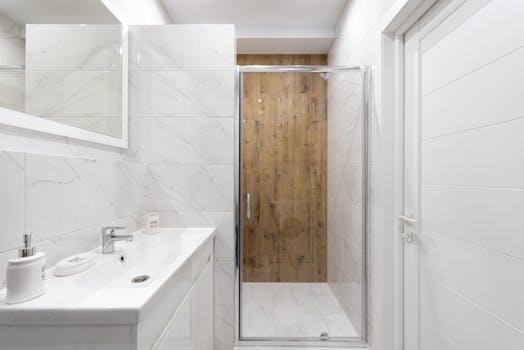Shower Door Bottom Guide Replacement⁚ A Comprehensive Guide
Is your shower door sticking? Rattling? A faulty bottom guide could be the culprit! This comprehensive guide will walk you through identifying, replacing, and maintaining your shower door’s bottom guide, ensuring smooth operation and preventing damage.
Understanding the Function of Shower Door Bottom Guides
Shower door bottom guides are small but crucial components in sliding shower door systems. Their primary function is to keep the shower door aligned within its track, ensuring smooth and effortless gliding during opening and closing. These guides prevent the door from swinging outwards, wobbling, or even derailing from the track, which can cause damage to the door, frame, or surrounding bathroom fixtures.
Typically made of plastic, nylon, or sometimes metal, bottom guides come in various designs to accommodate different door thicknesses and track styles. Some guides attach with adhesive, while others require screws for secure mounting. Regardless of the attachment method, their core purpose remains the same⁚ to maintain the door’s position and stability.

Without a properly functioning bottom guide, the shower door can become difficult to operate, noisy, and potentially unsafe. A missing or damaged guide can also lead to premature wear and tear on other components of the shower door system, such as rollers and tracks. Therefore, understanding the function of the bottom guide is the first step in addressing shower door issues and ensuring a long-lasting and smoothly operating shower enclosure. Recognizing the importance of this small part will make you appreciate its role in the overall functionality and safety of your shower.
In essence, the shower door bottom guide is the unsung hero of your shower, quietly working to keep everything in its place. Regular inspection and timely replacement of worn or damaged guides are essential for maintaining a properly functioning and enjoyable shower experience. Ignoring this small component can lead to bigger problems down the road, so take the time to understand its function and keep it in good condition.
Identifying the Correct Replacement Guide
Finding the right replacement shower door bottom guide is crucial for a successful repair. Before heading to the hardware store or browsing online, take the time to accurately identify the type of guide you need. Start by carefully examining the existing guide (if available) or the shower door and track system.
Determine the Door Type⁚ Is your shower door framed or frameless? Framed doors typically have guides that fit within the metal frame, while frameless doors may use different types of guides or seals. Knowing the door type narrows down your options significantly.
Measure the Channel Width⁚ The channel width refers to the space within the guide that accommodates the shower door. Use a caliper or ruler to precisely measure the width of the existing guide’s channel or the thickness of the shower door. Common sizes include 1/2 inch, 5/8 inch, and 7/16 inch. An accurate measurement is vital for a proper fit.
Identify the Mounting Style⁚ How is the guide attached to the shower door or track? Some guides use adhesive backing for easy installation, while others require screws. Note the number and placement of screw holes, if any. Choosing the correct mounting style ensures a secure and stable attachment.
Consider the Material⁚ Most bottom guides are made of plastic, but some are made of nylon or metal. Consider the durability and aesthetics of the material. If you’re replacing a plastic guide, you might consider upgrading to a more durable material for longer-lasting performance.
Take Pictures⁚ Capture clear photos of the existing guide, the shower door, and the track system. These images can be helpful when searching for a replacement online or consulting with a hardware store professional.
Check for Manufacturer Markings⁚ Look for any manufacturer names or part numbers on the existing guide or shower door. This information can significantly simplify your search for the correct replacement.
By carefully considering these factors, you can confidently identify the correct replacement shower door bottom guide and ensure a smooth and trouble-free installation. A little bit of research and attention to detail will save you time, money, and frustration in the long run.
Tools and Materials Required for Replacement
Before you begin the shower door bottom guide replacement process, it’s essential to gather all the necessary tools and materials. Having everything on hand will streamline the task and prevent unnecessary delays. Here’s a comprehensive list of what you’ll need⁚
Replacement Shower Door Bottom Guide⁚ This is the most crucial item. Ensure you have the correct type, size, and mounting style based on your identification process. Purchasing the wrong guide will render the entire process futile.
Screwdriver Set⁚ Depending on the mounting style of the guide, you’ll need a screwdriver set with various sizes and head types (Phillips head, flat head). A magnetic screwdriver can be particularly helpful for handling small screws in tight spaces.
Pliers⁚ Pliers can be useful for gripping and removing stubborn old guides or screws. Needle-nose pliers are especially helpful for reaching into confined areas.
Scraper or Putty Knife⁚ If the old guide is attached with adhesive, a scraper or putty knife will help remove any residue from the shower door or track. Choose a plastic scraper to avoid scratching the surfaces.
Cleaning Solution⁚ A mild cleaning solution (such as soap and water or rubbing alcohol) is necessary to clean the area where the new guide will be installed. This ensures proper adhesion if using an adhesive-backed guide.
Clean Rags or Paper Towels⁚ Use these to wipe down surfaces and remove any debris or cleaning solution residue.
Measuring Tape or Ruler⁚ You may need a measuring tape or ruler to ensure proper placement of the new guide.
Adhesive (if needed)⁚ If the replacement guide doesn’t come with adhesive backing or if you want to reinforce the attachment, purchase a suitable waterproof adhesive. Look for adhesives specifically designed for use in wet environments.
Drill with Drill Bits (if needed)⁚ If the new guide requires screws and the existing holes are stripped or misaligned, you may need a drill to create new pilot holes. Choose drill bits that are slightly smaller than the screw size.
Safety Glasses⁚ Protect your eyes from debris and splashes by wearing safety glasses throughout the replacement process.
1Work Gloves⁚ Gloves will protect your hands from sharp edges and cleaning solutions.
By gathering these tools and materials before you start, you’ll be well-prepared to tackle the shower door bottom guide replacement project efficiently and safely. Remember to always prioritize safety and follow the manufacturer’s instructions for all tools and materials.
Step-by-Step Replacement Process
Replacing a shower door bottom guide is a relatively straightforward process that can be accomplished with basic tools and a little patience. Follow these step-by-step instructions for a successful replacement⁚
Prepare the Area⁚ Begin by cleaning the area around the existing bottom guide. Remove any soap scum, mildew, or debris that may be present. Use a mild cleaning solution and a scrub brush or sponge. Rinse thoroughly and dry the area completely.
Remove the Old Guide⁚ Depending on how the old guide is attached, you’ll need to use different techniques. If it’s held in place by screws, use a screwdriver to remove them. If it’s attached with adhesive, gently pry it off using a scraper or putty knife. Be careful not to damage the shower door or track. If the adhesive is particularly stubborn, you can try heating it with a hairdryer to soften it.
Clean the Surface⁚ Once the old guide is removed, clean the surface thoroughly to remove any remaining adhesive residue. Use a scraper or putty knife to scrape off any large pieces of adhesive. Then, use a cleaning solution such as rubbing alcohol or adhesive remover to dissolve any remaining residue. Wipe the surface clean with a clean rag or paper towel.
Prepare the New Guide⁚ If the new guide comes with adhesive backing, peel off the protective liner. If it doesn’t have adhesive backing, apply a thin bead of waterproof adhesive to the back of the guide. Make sure to use an adhesive that is compatible with both the guide material and the shower door or track material.
Position the New Guide⁚ Carefully position the new guide in the same location as the old guide. Make sure it’s aligned properly with the shower door track. Press the guide firmly against the surface to ensure good adhesion. If the guide is held in place by screws, align it with the existing screw holes and insert the screws. Tighten the screws until the guide is securely in place.
Allow Adhesive to Cure (if applicable)⁚ If you used adhesive to attach the new guide, allow it to cure completely according to the manufacturer’s instructions. This may take several hours or even overnight. Avoid using the shower during this time to allow the adhesive to fully set.
Test the Door⁚ Once the adhesive has cured (if applicable), test the shower door to make sure it slides smoothly and doesn’t stick or rattle. If the door doesn’t slide smoothly, check the alignment of the guide and make sure it’s not rubbing against the door or track. You may need to adjust the position of the guide slightly to achieve optimal performance.
Clean Up⁚ Finally, clean up any debris or materials that you used during the replacement process. Dispose of the old guide and any used cleaning supplies properly.
By following these step-by-step instructions, you can successfully replace your shower door bottom guide and restore smooth operation to your shower door. Remember to always prioritize safety and follow the manufacturer’s instructions for all tools and materials.
Dealing with Difficult Removals

Sometimes, removing an old shower door bottom guide can be more challenging than anticipated. Years of accumulated soap scum, mineral deposits, and hardened adhesive can make the guide stubbornly difficult to dislodge. Here are some strategies for tackling particularly stubborn removals⁚
Heat Application⁚ As mentioned earlier, heat can be a powerful tool for softening stubborn adhesives. Use a hairdryer on a low setting to gently heat the area around the bottom guide. Move the hairdryer back and forth to avoid overheating any one spot. The heat will help to soften the adhesive, making it easier to pry off the guide. Be cautious when using heat near glass or plastic, as excessive heat can cause damage.
Adhesive Solvents⁚ If heat alone isn’t enough, try using an adhesive solvent. There are many commercially available adhesive removers that are designed to dissolve stubborn adhesives. Apply the solvent to the area around the bottom guide, following the manufacturer’s instructions. Allow the solvent to sit for the recommended amount of time to allow it to penetrate the adhesive. Then, try prying off the guide again. Be sure to use appropriate safety precautions when working with solvents, such as wearing gloves and eye protection, and working in a well-ventilated area.
Leverage and Patience⁚ Sometimes, all it takes is a little extra leverage and patience to remove a stubborn bottom guide. Use a putty knife or scraper to gently pry around the edges of the guide. Work slowly and carefully, applying gentle pressure. Avoid using excessive force, as this could damage the shower door or track. If the guide is particularly stubborn, try working on it from different angles.
Multi-Tool with Scraper Attachment⁚ A multi-tool with a scraper attachment can be a very effective tool for removing stubborn bottom guides. The vibrating action of the multi-tool helps to loosen the adhesive, while the scraper blade can be used to pry off the guide. Be careful when using a multi-tool near glass or plastic, as it can easily scratch or damage these materials. Use a low setting and apply gentle pressure.
WD-40⁚ WD-40 can sometimes be effective at loosening stubborn adhesives. Spray WD-40 around the edges of the bottom guide and let it sit for a few minutes. Then, try prying off the guide again. WD-40 can also help to lubricate the area, making it easier to slide the guide off.
Professional Help⁚ If you’ve tried all of these strategies and you’re still unable to remove the old bottom guide, it may be time to call in a professional. A plumber or handyman will have the tools and expertise to remove the guide without damaging your shower door or track.
Remember to always prioritize safety when working on any home repair project. Wear gloves and eye protection, and work in a well-ventilated area. If you’re not comfortable working on the project yourself, don’t hesitate to call in a professional.
Maintaining Your New Shower Door Bottom Guide

Once you’ve successfully replaced your shower door bottom guide, proper maintenance is crucial to ensure its longevity and optimal performance. Regular cleaning and preventative measures can significantly extend the life of your new guide and prevent future issues. Here’s a comprehensive guide to maintaining your shower door bottom guide⁚
Regular Cleaning⁚ The most important aspect of maintenance is regular cleaning. Soap scum, mineral deposits, and mildew can accumulate on the bottom guide over time, hindering its function and potentially causing damage. Clean the guide at least once a week, or more frequently if needed. Use a mild soap and water solution and a soft cloth or sponge to gently scrub the guide. Avoid using abrasive cleaners or scouring pads, as these can scratch or damage the plastic. For stubborn soap scum or mineral deposits, try using a solution of vinegar and water.
Preventative Measures⁚ In addition to regular cleaning, there are several preventative measures you can take to protect your bottom guide. After each shower, rinse the guide with clean water to remove any soap residue or debris. This will help to prevent the buildup of soap scum and mineral deposits. You can also apply a water repellent spray to the guide to help prevent water from clinging to it.
Lubrication⁚ Periodically lubricating the bottom guide can help to ensure smooth operation. Use a silicone-based lubricant, which is safe for use on plastic and won’t attract dirt or grime. Apply a small amount of lubricant to the guide and work it in with a soft cloth. Wipe away any excess lubricant. Avoid using oil-based lubricants, as these can damage the plastic and attract dirt.
Inspection⁚ Regularly inspect the bottom guide for any signs of wear or damage. Look for cracks, chips, or discoloration. If you notice any damage, replace the guide immediately. A damaged guide can cause the shower door to stick, rattle, or even come off its track.
Proper Ventilation⁚ Proper ventilation in your bathroom can help to prevent the growth of mildew and mold, which can damage the bottom guide. Make sure your bathroom is well-ventilated by opening a window or turning on the exhaust fan after each shower.
Avoid Harsh Chemicals⁚ Avoid using harsh chemicals or cleaners on the bottom guide, as these can damage the plastic. This includes bleach, ammonia, and other strong cleaning agents.
Check for Proper Alignment⁚ Make sure the shower door is properly aligned and that the bottom guide is correctly positioned. If the door is misaligned, it can put undue stress on the guide, causing it to wear out prematurely.
By following these simple maintenance tips, you can extend the life of your new shower door bottom guide and keep your shower door operating smoothly for years to come.
Troubleshooting Common Issues
Even with a new shower door bottom guide and diligent maintenance, you might encounter some common issues. Here’s a troubleshooting guide to help you identify and resolve them⁚
Door Still Sticks or Drags⁚ If the door continues to stick or drag even after replacing the bottom guide, the problem might not be solely the guide itself. Check the following⁚
- Track Obstructions⁚ Inspect the shower door track for any debris, soap scum buildup, or mineral deposits. Clean the track thoroughly with a brush and appropriate cleaner.
- Roller Issues⁚ If your shower door has rollers, examine them for wear, damage, or misalignment. Replace worn rollers or adjust their position as needed.
- Door Alignment⁚ Ensure the shower door is properly aligned within the frame. Misalignment can cause friction and make it difficult to slide smoothly. Adjust the door hinges or frame if necessary.
New Guide Doesn’t Fit⁚ If the replacement guide doesn’t fit properly, double-check the following⁚
- Correct Model⁚ Verify you purchased the correct replacement guide model for your specific shower door. Compare the new guide to the old one to ensure they are identical in size and shape.
- Track Compatibility⁚ Ensure the guide is compatible with your shower door track. Some guides are designed for specific track types.
- Installation Issues⁚ Make sure you are installing the guide correctly. Refer to the manufacturer’s instructions or online tutorials.
Guide Keeps Coming Loose⁚ If the bottom guide keeps coming loose, address these potential causes⁚
- Insufficient Adhesive⁚ If the guide is attached with adhesive, ensure you are using a strong, waterproof adhesive specifically designed for this purpose. Clean the surfaces thoroughly before applying the adhesive.
- Damaged Track⁚ If the track is damaged or warped, it might not provide a secure surface for the guide to attach to. Repair or replace the track if necessary.
- Improper Installation⁚ Double-check that you are installing the guide correctly and applying enough pressure to ensure a secure bond.

Noise Issues (Rattling or Squeaking)⁚ A rattling or squeaking shower door can be annoying. Here’s how to address the noise⁚
- Loose Guide⁚ Ensure the bottom guide is securely attached and not vibrating against the track.
- Dry Rollers⁚ If your door has rollers, lubricate them with a silicone-based lubricant to reduce friction and noise.
- Track Debris⁚ Clean the track thoroughly to remove any debris that might be causing the noise.
Water Leaks⁚ While the bottom guide primarily keeps the door aligned, it can indirectly affect water leakage. Ensure the guide is properly positioned to prevent water from escaping. Check the door sweep or seal along the bottom edge of the door and replace it if damaged.
If you’ve tried these troubleshooting steps and are still experiencing issues, consult a professional handyman or shower door repair specialist for assistance. They can diagnose more complex problems and provide expert solutions.

No Responses